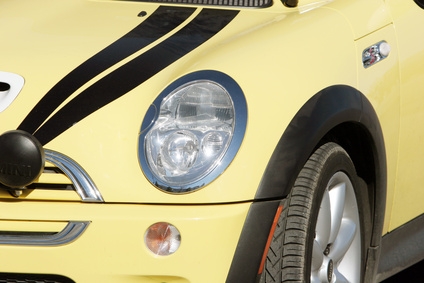
The newest generation Mini Cooper is more of a spiritual homage to it's seminal predecessor than a true evolution of the chassis. Fully engineered and built by those Bavarian madmen at BMW, the Cooper actually has much more in common with the BMW 1 and 3-Series than anything built in Longbridge, England. This is both the Cooper's biggest fault and strongest virtue: it's actually quite heavy for its size, but BMW's expert chassis engineers have negated the mini's extra heft by incorporating a number of design elements from the 3-series. Combined with the Cooper's powerful engine and short wheelbase, this engineering makes for one seriously stout package after a bit of modification.
Shed weight. Given it's dimensions, the Mini's 2,700 pound mass makes it the pot-belly pig of sport compact cars. Start by replacing the 53 pound sunroof with two panels made of fiberglass or carbon fiber weighing between seven and ten pounds total. This will remove weight from the very top of the car, bringing the center of gravity much lower. Purchase and install a lightweight, aftermarket catalytic-converter-back ("cat-back") exhaust system to replace the Mini's 44 pounds worth of resonators and mufflers.
Install a set of lightweight (under 15 pounds), forged-aluminum racing wheels and the widest ultra high performance tires that will fit. Use a set of 15-inch diameter wheels instead of the 17's that came optional on the Mini Cooper S. Not only are 15's debatably better looking on the small Mini, you'll find that the popularity of this size means a wide selection of wheels and tires at reasonable prices. The lightweight wheels will shave about 20 pounds of un-sprung mass (mass not supported by the suspension), which pays huge dividends in all aspects of performance.
Install a set of short struts to get the cooper closer to terra firma. The Mini already uses one of the best suspension designs on the planet, so you don't really need to install overly stiff springs and shocks as long as you use a decent set of tires. Lowering the car by 1.5 inches will help the suspension to do its job, but don't just use a set of lowering springs to do it. The stock Cooper only has about 2.5 inches of upward travel, so you'll need to install a set of struts with a shorter shock absorber to avoid constant bottoming out.
Install a supercharger and associated injectors, computer and fuel pump from a Cooper S. If you already have a supercharged Cooper S, then install an overdrive supercharger pulley to increase the compressor speed and make more boost. If you're after some truly huge gains, consider twin-charging your Cooper S by installing a GT28R-sized turbo to feed the supercharger. This approach isn't easy, but it will net you over 300 horsepower to the wheels.
Install a set of brake pads with an extremely aggressive compound (R4S or equivalent) to take advantage of the Cooper's slightly oversized brake rotors. Install a set of braided-steel brake lines in place of the stock rubber units to increase brake pedal feel and send the maximum amount of pressure to your new pads.